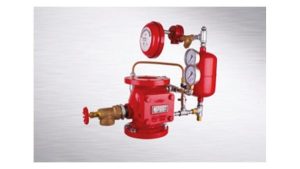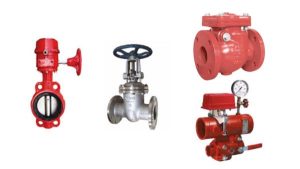
Gate Valve.
Mainly for on/off control, with low pressure drop. Gate valves are primarily designed to start or stop flow, and when a straight-line flow of fluid and minimum flow restriction are needed. In service, these valves generally are either fully open or fully closed. The disk of a Gate valve is completely removed when the valve is fully open; the disk is fully drawn up into the valve Bonnet. This leaves an opening for flow through the valve at the same inside diameter as the pipe system in which the valve is installed. A Gate valve can be used for a wide range of liquids and provides a tight seal when closed.
Butterfly Valve.
Butterfly valve used for isolating or regulating flow. The closing mechanism takes the form of a disk. Operation is similar to that of a ball valve, which allows for quick shut off. Butterfly valves are generally favored because they are lower in cost to other valve designs as well as being lighter in weight, meaning less support is required. The disc is positioned in the center of the pipe, passing through the disc is a rod connected to an actuator on the outside of the valve. Rotating the actuator turns the disc either parallel or perpendicular to the flow. Unlike a ball valve, the disc is always present within the flow, therefore a pressure drop is always induced in the flow, regardless of valve position.
Alarm Check Valve.
The alarm check valve is a water flow alarm device designed for vertical installation in the main supply to a wet pipe sprinkler system. When a flow of water from the system equals or exceeds that of a single sprinkler, the valve is to actuate a fire alarm. It is designed to hold back water pressure in the piping system until the sprinkler is activated, to be used in wet pipe sprinkler installations in buildings not subjected to freezing temperatures. Alarm valve includes trim packages valves, Gauges, Pressure Switch, Fittings & Nipples to provide Retard Chamber connection, Drain Connections & Alarm test by pass.
Zone Control Valve.
Zone Control Valve is a system designed to separate the area in case of maintenance and to get the indication of fire zone on a combination of Butterfly valve, Flow Switch, Pressure Gauge and Test & Drain Valves. A floor or zone control valve closes off all flow into or out of the fixed system zone it controls. They would be used for maintenance, to shut off a system that has tripped, or avoiding flow if an open head system. Since all flow is stopped, including fire suppression flows, the valves must be inspected regularly and monitored. In a large structure the valves would have tamper switches to make lifeeasier on the monitors. The use of an OS&Y valve, mounted where easily seen would also be useful.
The check valve prevents reverse flow in the system, whether from a potable water system in the building back into the distribution main or from thefire suppression systems into the water main. Because fire apparatus, connected to the FDC may provide more pressure than the main a check valveor backflow preventer is installed between the main and the FDC. There may be check valves (clappers) in the FDC to prevent water being pumped infrom exiting a used port. Depending on the design of the system checks may be necessary in the riser or laterals to prevent water flowing in the system from causing a back flow in certain parts of the system. While not likely it is possible for water in sinks and storage tanks to drain into the rest of the piping if a check valve is not in place.
Non – Return Valve
A non-return valve or one-way valve is that normally allows fluid (liquid or gas) to flow through it in only one direction. Check valves are two-port valves, meaning they have two openings in the body, one for fluid to enter and the other for fluid to leave.
An important concept in check valves is the cracking pressure which is the minimum upstream pressure at which the valve will operate. Typically the check valve is designed for and can therefore be specified for a specific cracking pressure. Check valves work automatically and most are not controlled by a person or any external control; accordingly, most do not have any valve handle or
Check valves work automatically and most are not controlled by a person or any external control; accordingly, most do not have any valve handle or stem. The bodies (external shells) of most check valves are made of plastic or metal.

